| |
National Trust for Historic Preservation Issues 2007 List of America's 11 Most Endangered Historic Places
Summary: America’s
heritage is at risk. From the storied waterfronts of Brooklyn
to the neon-clad mom-and-pop motels of Route 66, some of America’s
irreplaceable landmarks are threatened, and the National Trust for
Historic Preservation has named 11 sites to its 2007 list of America’s
11 Most Endangered Historic Places. “The sites
on this year’s list of America’s 11 Most Endangered Historic
Places embody the diversity and complexity of America’s story,
and the variety of threats that endanger it,” said Richard
Moe, Hon. AIA, president of the National Trust for Historic Preservation. “The
places on this year’s list span the continent and encompass
the breadth of the American experience. Each one is enormously important
to our understanding of who we are as a nation and a people.”
Sites on the 2007 list of America’s 11 Most Endangered Historic Places are:
B rooklyn’s Industrial Waterfront rooklyn’s Industrial Waterfront
New York
Once a booming 19th-century industrial waterfront supported by generations
of immigrants, Brooklyn’s heritage is at risk as historic dockyards
and factories are being demolished by developers anxious to cash
in on the area’s newly hip status. Brooklyn’s real estate
market is booming. The City’s Department of Buildings issued
1,740 new building permits and 1,924 demolition permits in Brooklyn
in 2005. And the city is rezoning to make way for residential development
without adequately planning for the preservation of Brooklyn’s
industrial heritage, according to the Trust.
Photo © Municipal Art Society of New York.
 El Camino Real National Historic Trail El Camino Real National Historic Trail
New Mexico
The earliest Euro-American trade route in the United States, the
El Camino Real de Tierra Adentro, known for its austere physical
beauty, rural solitude, and remote isolation, is threatened by a
$225 million commercial Spaceport, a venture planned adjacent to
one of the most pristine and sacred segments of the trail. The proposed
Spaceport site is within a 90-mile stretch of waterless desert located
45 miles northeast of Las Cruces—the Jornada del Muerto—and
immediately adjacent to El Camino Real. The near-pristine quality
of the air, animal habitats, and the public’s ability to visit,
experience, and enjoy the trail and its environs will be compromised.
Photo © Jean Fulton, El Camino Real de Tierra Adentro Trail Association.
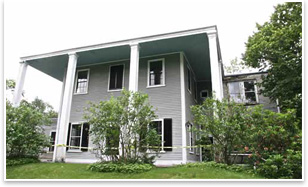 H.H. Richardson House H.H. Richardson House
Brookline, Mass.
The last home and studio of famed 19th-century American architect
Henry Hobson Richardson, creator of Boston’s much loved landmark
Trinity Church, is vacant and vulnerable to demolition unless a preservation-minded
buyer comes forth to rescue the legacy of the man who created the “Richardsonian
Romanesque” style. The house on Cottage Street stands in the
Green Hill National Historic District, near the home of Frederick
Law Olmsted, the great landscape architect who was Richardson’s
close friend and frequent collaborator. It could be sold as a tear-down.
Photo © Allan Galper.
 Hialeah Park Hialeah Park
Hialeah, Fla.
The 1925 racetrack known for its stunning Mediterranean architecture
and pink flamingos, Hialeah Park—frequented by celebrities
such as Winston Churchill, Harry Truman, and Seabiscuit—is
threatened with a planned 3,760-unit condo and apartment complex
with nearly a million square feet of retail and 200,000 square feet
of office space, which would destroy much of the storied park. The
park, designated a sanctuary for the American flamingo by the Audubon
Society, has a lake with several islands inhabited by large flocks
of 200-300 pink flamingos, direct descendants of those originally
brought from Cuba and South America. Pictured is the Flamingo Stakes
in 2001, Hialeah Park Race Course.
Photo © Alex Fuentes/The Citizens of South Florida for the Preservation
of the Hialeah Race Track.
 Historic Places in Powerline Corridors Historic Places in Powerline Corridors
Virginia, West Virginia, Maryland, Pennsylvania, New York, New Jersey, Delaware
Seven states—many of them in the Mid-Atlantic region—are
waging battles to protect everything that’s irreplaceable about
their communities as massive 150-foot-tall, 75-foot-wide power lines
are planned. Proposed lines would cut through private land, publicly
held open space, neighborhoods, historic sites, historic districts,
and magnificent view-sheds. For example, the National Park Service
has identified at least 55 National Parks and 14 heritage areas within
the proposed Mid-Atlantic powerline corridor, which also encompasses
African-American historic sites, numerous scenic rivers and byways,
and the nation’s greatest concentration of Civil War battlefields.
Unfortunately, the fast-track approval process for the corridor is
likely to preclude meaningful federal protection for historic resources
as mandated by the National Historic Preservation Act and National
Environmental Policy Act, the Trust says. Pictured is Southern Fauquier
Power Line in Virginia.
Photo © Piedmont Environmental Council of Virginia.
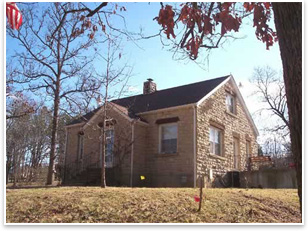 Historic Structures Historic Structures
Mark Twain National Forest, Mo.
Established by President Franklin D. Roosevelt in 1939, the 1.5-million-acre
Mark Twain National Forest is known for rocky bluffs, pastoral views,
and historical sites that speak to the region’s rich heritage—from
intact 19th-century frontier farmsteads to New Deal-era fire lookouts
and ranger stations. Today, due to U.S. Forest Service budget limitations,
many properties are vacant, unsecured, deteriorating, and threatened
with demolition. According to the Trust, the Forest's Facilities
Master Plan, developed in 2005 without public involvement or consultation
with the Missouri State Historic Preservation Office, demonstrates
a clear preference for new construction over retention of existing
historic structures, contrary to several federal mandates. Pictured
is Ava Ranger Station in Mark Twain National Forest, Ava, Mo.
Photo © Jennifer Sandy, National Trust for Historic Preservation
Midwest Regional Office.
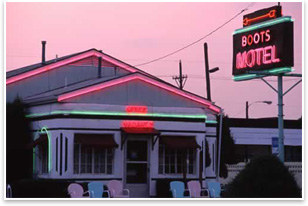 Historic Route 66 Motels Historic Route 66 Motels
Illinois to California
Affectionately called “The Mother Road,” Route 66 is
known for quirky roadside attractions and unique mom-and-pop motels,
often clad in neon, that were constructed between the late 1920s
and late 1950s. In recent years, Route 66 motels in hot real-estate
markets have been torn down at record rates, while in cold real-estate
markets, motels languish and are being reclaimed by the forces of
nature. The final decommissioning of Route 66 in 1985 coincided with
a renewed appreciation for this American icon and recognition that
the remaining significant structures, features, and artifacts associated
with the road should be preserved. Pictured is Boots Motel, Carthage,
Mo.
Photo © Jim Ross.
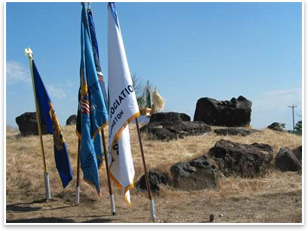 Minidoka Internment National Monument Minidoka Internment National Monument
Jerome County, Idaho
From 1942 to 1945, thousands of Nikkei (Japanese-American citizens
and immigrants of Japanese ancestry) were sent to south central Idaho
to live in camps under armed guard at the Minidoka Relocation Center.
More than two-thirds of internees at the 10 relocation centers were
American citizens by birth. Those who came to the Minidoka Relocation
Center, also known as the Hunt Camp, found a hastily constructed
facility ill-suited for the extreme climate of south central Idaho.
Today a national monument, the site, which once contained more than
600 buildings, offers scant visitor services or interpretive information
and is routinely looted of artifacts. The monument also is threatened
by insensitive local land-use planning, including the proposed siting
of a massive animal feed operation just over a mile away.
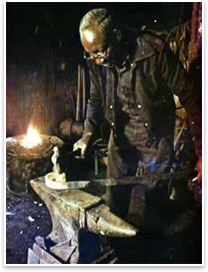 Photo © National Trust for Historic Preservation Western Regional
Office. Photo © National Trust for Historic Preservation Western Regional
Office.
Philip Simmons Workshop and Home
Charleston, S.C.
Beloved master blacksmith Philip Simmons has spent the better part
of 80 years adorning his hometown of Charleston with intricate ornamental
ironwork—gates, fences, stair rails, and window grills—that
help shape the city’s distinctive architectural character.
But, with no plans to preserve his home and studio, the legacy of
this 95-year-old artisan is in jeopardy. In the early 1930s, Simmons
was one of 15 blacksmiths operating in the community, but now his
forge is one of only two on the Charleston peninsula. Pictured is
Simmons in his workshop.
Photo © The Philip Simmons Foundation, Charleston, S.C.
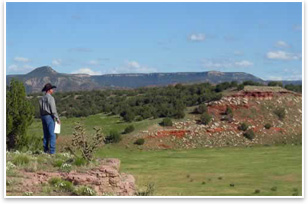 Pinon Canyon Pinon Canyon
Colorado
In southeastern Colorado, under uninterrupted blue skies, Pinon Canyon
is an area of scenic buttes, river valleys, family ranches, and historic
and archeological sites that span 11,500 years. The area is threatened
by the U.S. Army’s plans to expand its maneuver training ground
by as much as 408,000 acres, a move that could lead to forced condemnation
of private lands and damage or destroy historic Santa Fe Trail monuments
and ranches. Additionally, this rugged and scenic area contains historic
and prehistoric archeological sites, most of which have remained
almost completely undisturbed. Pictured is Rancher Steve Wooten on
his ranch, Purgatoire Valley.
Photo © Jim Lindberg, National Trust for Historic Preservation
Mountains Plains Office.
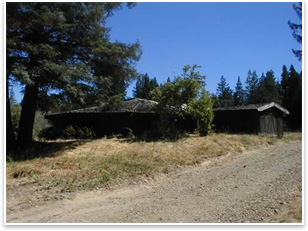 Stewart's Point Rancheria Stewart's Point Rancheria
Sonoma County, Calif.
The Kashia Pomo Native American tribe has inhabited this Northern
California land for thousands of years. But because a federal program
to protect tribal historic resources is seriously underfunded, the
Kashia, like many tribes, is losing its sacred and historic sites
to looters, vandals, and the elements. The Kashia’s Regalia
House, where cultural items are stored for use in religious ceremonies,
has been looted on several occasions. The house, which is in desperate
need of repair, contains items that are important to Kashia religious
ceremonies dating back centuries. Pictured is the current Kashia
Roundhouse.
Photo © Bambi Kraus.
|
|












